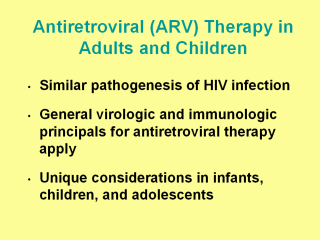| front |1 |2 |3 |4 |5 |6 |7 |8 |9 |10 |11 |12 |13 |14 |15 |16 |17 |18 |19 |20 |21 |22 |23 |24 |25 |26 |27 |28 |29 |review |
 |
-The Working Group used general principles of
infectious diseases as a foundation for development of the guidelines and
identified a number of important concepts that need to be considered in the
formulation of current and future guidelines. -Although the pathogenesis of HIV infection and the general virologic and immunologic principles underlying the use of antiretroviral therapy are similar for all HIV-infected persons, there are unique considerations needed for HIV-infected infants, children, and adolescents. Most HIV infections in children are acquired perinatally, and most perinatal transmission occurs during or near the time of birth, which raises the possibility of initiating treatment in an infected infant during the period of initial (i.e., primary) HIV infection (if sensitive diagnostic tests are used to define the infantís infection status early in life). Perinatal HIV infection occurs during the development of the infantís immune system; thus, both the clinical manifestations of HIV infection and the course of immunologic and virologic markers of infection differ from those for adults. -Treatment of perinatally infected children will occur in the context of prior exposure to ZDV and other antiretroviral drugs used during pregnancy and the neonatal period, for maternal treatment, to prevent perinatal transmission, or both [6, 7 ]. Additionally, drug pharmacokinetics change during the transition from the newborn period to adulthood, requiring specific evaluation of drug dosing and toxicity in infants and children. Finally, optimizing adherence to therapy in children and adolescents requires specific considerations. |